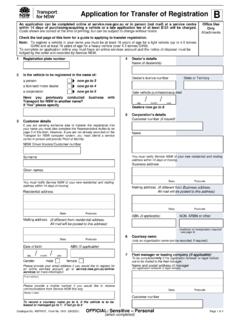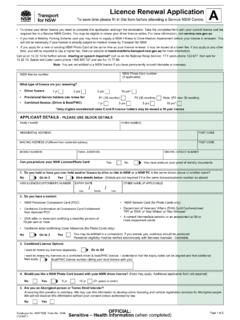Transcription of Mark Scheme (Results) - Edexcel
1 Mark Scheme (Results). Summer 2018. Pearson Edexcel GCE A Level In Economics A (9EC0). Paper 01 Markets and Business Behaviour Edexcel and BTEC Qualifications Edexcel and BTEC qualifications are awarded by Pearson, the UK's largest awarding body. We provide a wide range of qualifications including academic, vocational, occupational and specific programmes for employers. For further information visit our qualifications websites at or Alternatively, you can get in touch with us using the details on our contact us page at Pearson: helping people progress, everywhere Pearson aspires to be the world's leading learning company. Our aim is to help everyone progress in their lives through education. We believe in every kind of learning, for all kinds of people, wherever they are in the world. We've been involved in education for over 150 years, and by working across 70 countries, in 100.
2 Languages, we have built an international reputation for our commitment to high standards and raising achievement through innovation in education. Find out more about how we can help you and your students at: Summer 2018. Publications Code 9EC0_01_1806_MS. All the material in this publication is copyright Pearson Education Ltd 2018. General Marking Guidance All candidates must receive the same treatment. Examiners must mark the first candidate in exactly the same way as they mark the last. Mark schemes should be applied positively. Candidates must be rewarded for what they have shown they can do rather than penalised for omissions. Examiners should mark according to the mark Scheme not according to their perception of where the grade boundaries may lie. There is no ceiling on achievement. All marks on the mark Scheme should be used appropriately.
3 All the marks on the mark Scheme are designed to be awarded. Examiners should always award full marks if deserved, if the answer matches the mark Scheme . Examiners should also be prepared to award zero marks if the candidate's response is not worthy of credit according to the mark Scheme . Where some judgement is required, mark schemes will provide the principles by which marks will be awarded and exemplification may be limited. When examiners are in doubt regarding the application of the mark Scheme to a candidate's response, the team leader must be consulted. Crossed out work should be marked UNLESS the candidate has replaced it with an alternative response. Question Answer Mark number 1(a) Application 2. Application: Calculation of original opportunity cost of producing 50. capital goods is 120 -100=20 consumer goods. (1.)
4 Mark). Calculation of new opportunity cost of 50 capital goods is 170 -140=30 consumer goods. (1 mark). (2). Question Answer Mark number 1(b). The only correct answer is D. A is not correct because this would be describing a change in actual output such as W to V from inside the PPF XY. (1). B is not correct because PPF shows potential output and not the cost of output C is not correct because PPF shows potential output and not the demand for a good or service Question Answer Mark number 1(c) Knowledge 1, Analysis 1. Knowledge/understanding: 1 mark for Position W represents an inefficient allocation of resources (1). unemployment of resources (1). Analysis: 1 mark for It is possible to increase output of both consumer goods and capital goods by using unemployed resources (1). The economy could produce at either 100 or 140.
5 Consumer goods but is currently producing 80 (1). The country is operating inside the PPF (1). (2). Question Answer Mark number 2(a) Application 2. Application: 1 mark for appropriate calculation 2 73 million = 146 million (1). OR. 73 million = million (1). OR. 73 million (1). OR. correct answer with no millions (1). Answer = million (accept between 128. million and 129 million). Award 2 marks for correct answer (128m) (2). Question Answer Mark number 2(b) Knowledge 1, Analysis 1. Knowledge: 1 mark for The demand for use of gaming machines is likely to increase (1). It is a substitute for national lottery tickets (1). Substitutes have a positive cross elasticity of demand (1). Analysis: 1 mark for Increase by 128% in response to a 100%. increase in the price of national lottery tickets (1). cross elasticity of demand indicates they are close substitutes (1).
6 (2). Question Answer Mark number 2(c). The only correct answer is C. A is not correct because the flood defence Scheme is non- exclusive B is not a private good because flood defence Scheme is non-exclusive so you are unable to charge private individuals that benefit from the Scheme D is not correct because it is a distractor in lacking meaning but also indicating that the candidate is confusing rivalry with the non-rivalrous nature of public goods (1). Question Answer Mark number 3 (a) Application 2. Application 2: 1 mark for appropriate calculation /formula 489 000 (1). 100. OR. 489 000 (1). Answer = 6 357. Award 2 marks for correct answer (6 360) (2). Question Answer Mark number 3(b) The only correct answer is C. A is not correct because the candidate has mistakenly done the average house price in North East of England to the average house price in London B is not correct because the candidate has made a computational error D is not correct because the candidate has made a computational error (1).
7 Question Answer Mark number 3(c) Knowledge 1, Analysis 1. Knowledge / understanding: 1 mark for one reason differences in average income or wealth (1). employment or unemployment rates (1). migration or population change (1). foreign buyers (1). availability of land to build on (1). Analysis: 1 mark for a linked development Higher average income in London mean people are able to obtain larger mortgages and so pay higher prices (1). Higher employment rate or lower unemployment rate in London mean greater demand for housing from its population (1). Foreign buyers attracted to invest in London due to high rental returns or expectations of increase in value of property or better market knowledge (1). Shortage of land to build on in London, especially with green belt restrictions (1). (2). Question Answer Mark number 4(a) Knowledge 2, Application 2.
8 Knowledge/Understanding: (up to 2 marks). 1 mark for identifying each correct price/output level Identify profit maximisation position: for example, where MC=MR or output level 25 or price 17 (1). Identify revenue maximisation position: for example, where MR=0 or output level 36 or price 12 (1). Application: (up to 2 marks). Calculate total profit at profit maximisation position: for example, total revenue total cost = total profit: 425 200 = 225 (1). OR. 17- 8= 9, 9 25 = 225 (1). OR. Calculate total profit at revenue maximisation position: 432 - 324 = 108 (1). OR. 12- 9= 3, 3 36 = 108 (1). 108 - 225 = - 117 or 117. Award full 4 marks for - 117 or fall of 117 or 117. (4). Question Answer Mark number 4(b). The only correct answer is B. A is not correct because sales maximisation occurs when AC. equals AR which is at an output higher than revenue maximisation C is not correct because AC is higher at sales maximisation output than revenue maximisation D is not correct because abnormal profit is removed and only normal profit is now made (1).
9 Question Answer Mark number 5(a) The only correct answer is A. B is not correct because the candidate has divided by the new year rather than the original year C is not correct because the candidate has looked at the difference in quantity sold between 2014 and 2015 rather than answering the question between 2011 and 2015. D is not correct because the candidate has looked at the decrease in the quantity of PC's not the percentage decrease (1). Question Answer Mark number 5(b) Knowledge 1, Analysis 1. Knowledge: 1 mark for likely reason in the decrease in sales of PCs Development of substitutes such as Tablets or iPads or iPhones (1). Fall in global real incomes (1). Fall in price of substitutes (1). Analysis: 1 mark for linked development Tablets are more convenient to carry round (1). New technology in other personal devices so becoming more powerful in their functions (1).
10 Fall in global incomes means that consumers are less likely to buy normal goods such as PCs (1). (2). Question Answer Mark number 5(c) Application 2. Application 2 1 mark for appropriate calculation /formula the sum of 5 largest figures = 190 239 (1). 190 239 (million) 100. 276 700 (million). Answer = (Accept between 68% and 69%). Award 2 marks for correct answer ( ). (2). Question Answer Mark number 6(a) Knowledge 1, Application 1, Analysis 3. Knowledge/Understanding: (up to 1 mark). Real price of gas and electricity refers to their price adjusted to remove the effects of inflation (1). Increase in demand (1). Decrease in supply. (1). The lack of competition (1). Application: (up to 1 mark) Figure 1 indicates the real price of gas and electricity has increased since 2004: electricity from 70 to 119 or rises 70% (accept approximations) (1).











